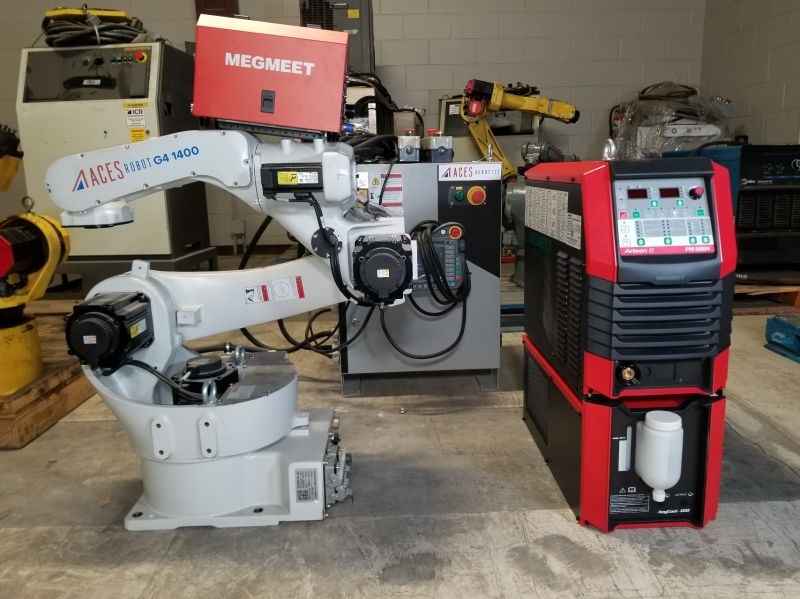As manufacturing becomes more automated, the use of collaborative robots (cobots) in laser welding is gaining popularity. Cobots, designed to work alongside human operators, offer several advantages for companies looking to improve efficiency and maintain precision in their welding processes. In this article, we’ll dive into how laser welding cobots work, their benefits, and what to consider when integrating them into your production line.
1. What is a Laser Welding Cobot?
A laser welding cobot is a collaborative robot specifically designed to perform laser welding tasks alongside human workers. Unlike traditional robotic systems, cobots are smaller, easier to program, and safer to operate around humans. These robots bring flexibility to the production floor, allowing businesses to scale operations without sacrificing precision.

Key Benefits of Cobots in Laser Welding:
Ease of use: Cobots are easier to program and reconfigure for different welding tasks.
Safety: They come equipped with advanced sensors to safely work alongside humans.
Cost-effectiveness: Cobots are generally more affordable than traditional industrial robots.
2. How Cobots and Laser Welding Systems Work Together
Integrating cobots with laser welding systems requires seamless communication between the robot and the laser welding power source. A typical laser welding cobot system includes:
Laser Welding Power Source: Provides the energy needed to create the weld.
Cobot Arm: The robot arm that positions the laser welding head precisely.
Controller: Manages the operation of both the cobot and the laser system, ensuring accuracy.
When cobots are paired with advanced laser welding systems like the Lux 4-in-1 Laser Welding Machine (1.5KW/2KW/3KW), they can handle a wide variety of welding applications, ranging from thin materials to thicker metals. These systems ensure precise welds while minimizing waste and operational downtime.
3. Choosing the Right Laser Welding Power Source
Selecting the correct laser welding power source is crucial for achieving high-quality welds. The power source provides the energy that’s directed through the laser to create the weld. For aluminum and other reflective metals, having a powerful and reliable laser source is essential.
When evaluating a laser welding power source, consider the following:
Power Output: More power is required for thicker metals or high-speed production.
Compatibility with Cobots: Ensure the power source can be easily integrated with a cobot system for seamless operation.
Maintenance and Durability: Look for machines with minimal maintenance requirements to avoid production downtime.
The Lux 4-in-1 Laser Welding Machine (1.5KW/2KW/3KW) offers a flexible power range and compatibility with robotic systems, making it a great choice for businesses looking to optimize their welding operations.

4. How to Integrate a Laser Welding Cobot System
Successfully integrating cobots into your laser welding processes involves several key steps. Here’s a breakdown of what to consider:
1) Assess Your Production Needs
Determine the volume and complexity of the welding tasks that a cobot will perform. Cobots can be used for repetitive tasks like seam welding, or for more complex jobs requiring variable inputs.
2) Select the Right Cobot
Ensure that the cobot you choose can handle the required load and reach. Many cobots are compact and designed for smaller parts, so if you’re working with larger components, you may need a more robust system.
3) Program for Precision
Cobots are easier to program than traditional robots, but it’s still essential to fine-tune the programming for laser welding tasks. Precision is key in laser welding, and modern cobots allow operators to teach the robot tasks quickly with intuitive interfaces.
4) Ensure Proper Safety Protocols
Cobots are designed with safety in mind, but integrating them into a laser welding system still requires the proper use of shielding, ventilation, and protective gear for human operators.
5. The Future of Cobots in Welding: Efficiency and Flexibility
As manufacturing trends toward more automation, the combination of cobots and laser welding systems will become increasingly common. Cobots offer unparalleled flexibility—they can be redeployed quickly for new tasks, unlike traditional industrial robots, which are often fixed to specific tasks.
For companies that want to remain competitive, investing in a cobot-powered laser welding system can improve efficiency, reduce operational costs, and provide a higher level of production flexibility. Megmeet Welding Technology is leading the way in providing intelligent solutions for laser welding. Explore our wide range of products, including the Lux 4-in-1 Laser Welding Machine (1.5KW/2KW/3KW), designed for both cobot and traditional robotic systems.
Related articles:
1. How Automatic Welders and Cobot Maximum your Productivity?
2. Robots & Cobots Revolutionizing Welding Automation
3. A Comprehensive Guide to Cobot Welding
4. How to Choose the Correct Welding Torch for Robotic Welding?
5. Megmeet 1,500 Robot Welding Power Sources Signing Ceremony!





